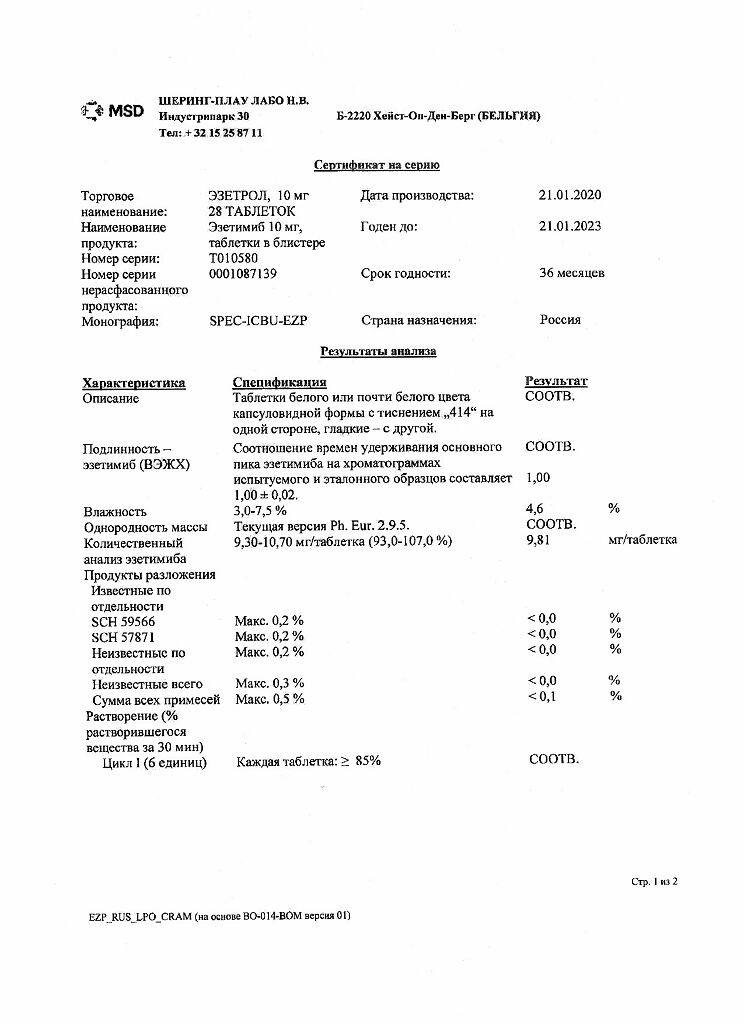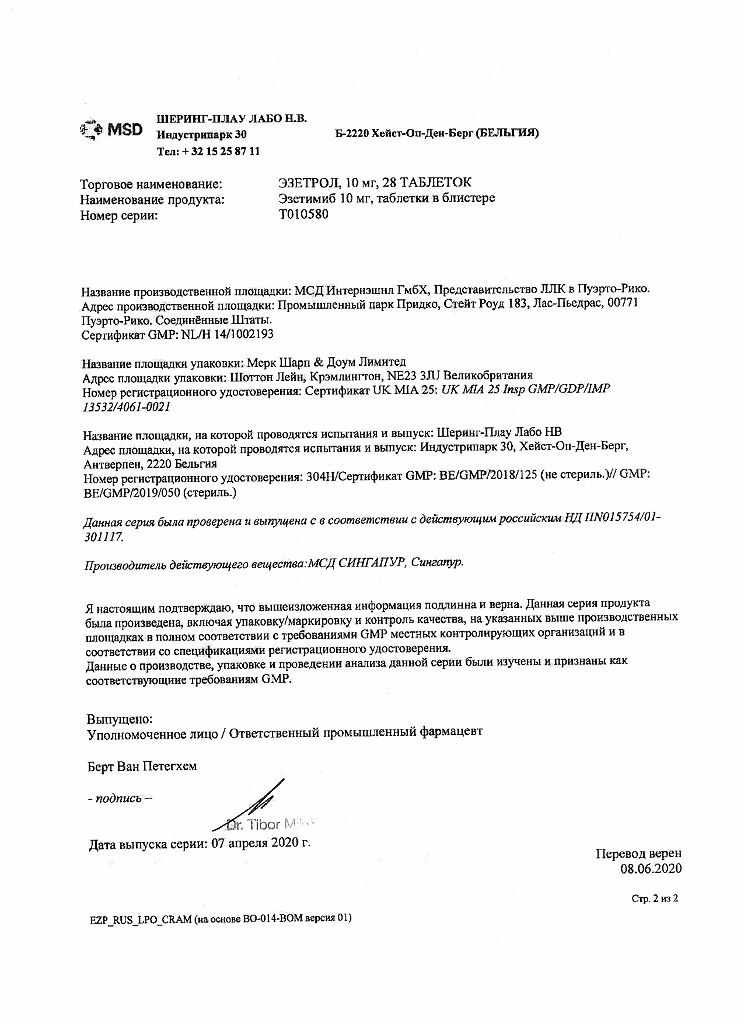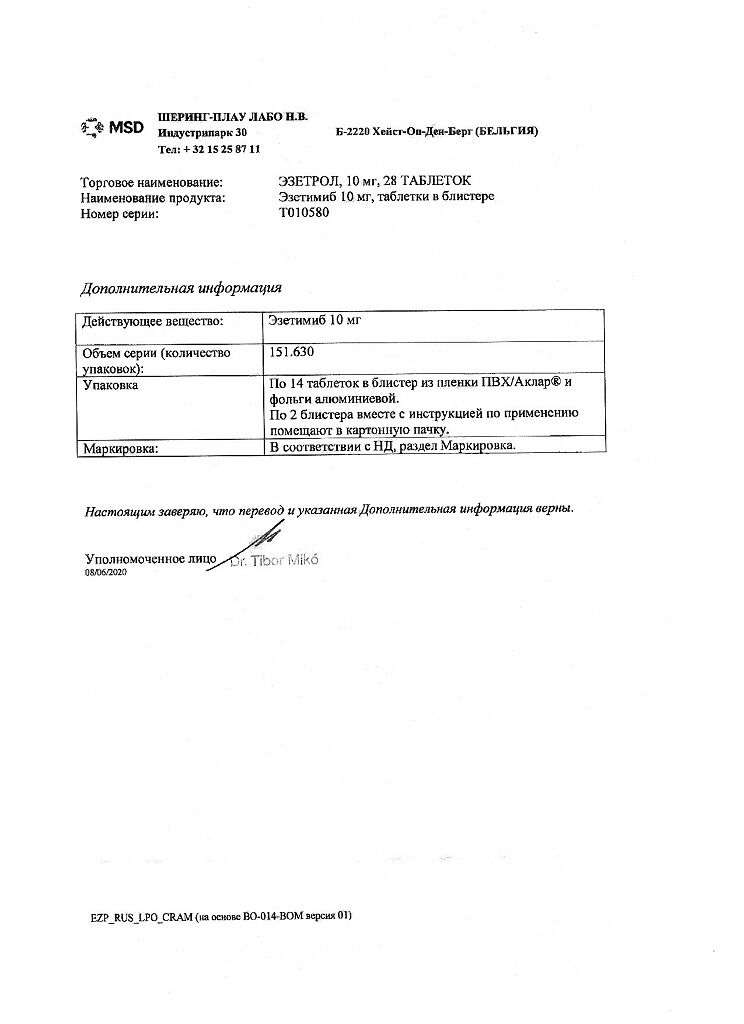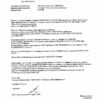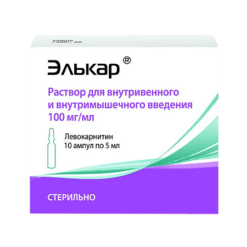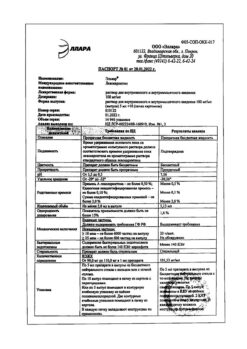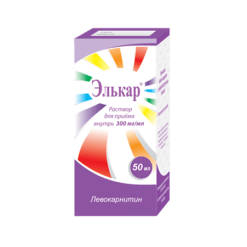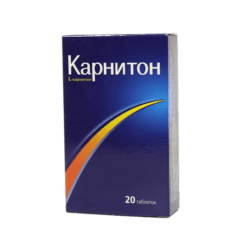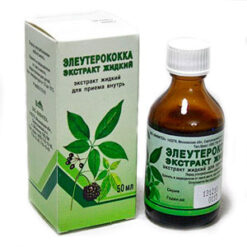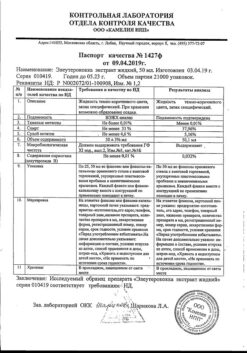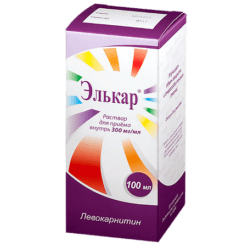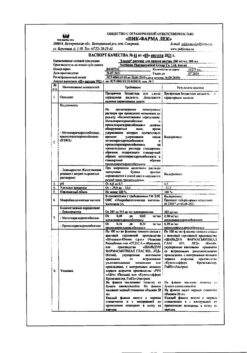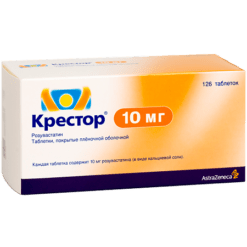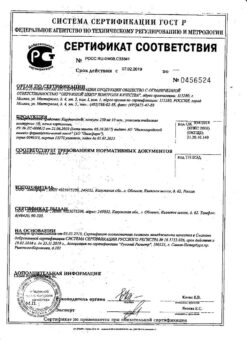No products in the cart.
Ezetrol, tablets 10 mg 28 pcs
€104.43 €87.03
Description
EZETROL is a selective representative of a new class of hypolipidemic drugs that reduce absorption of cholesterol (CHL) in the intestine, including CHL of vegetable fats.
The mechanism of action of EZETROL differs from the mechanism of action of other classes of hypolipidemic drugs (e.g., statins, bile acid sequestrants, fibrates). Unlike bile acid sequestrants, Ezetimibe does not increase bile acid excretion and does not inhibit CL synthesis in the liver unlike statins.
On entry into the small intestine, Ezetimibe localizes at the brush border of the small intestine and slows down absorption of CHL, which leads to a decrease in the entry of CHL from the intestine into the liver.
After 2 weeks of use, EZETROL reduces intestinal ChL absorption by 54% compared to placebo.
Pharmacokinetics
.
Indications
Indications
– increased cholesterol levels in the blood;
– coronary heart disease;
– atherosclerosis.
Pharmacological effect
Pharmacological effect
EZETROL is a selective representative of a new class of lipid-lowering drugs that reduce the absorption of cholesterol (CL) in the intestine, including CL of vegetable fats.
The mechanism of action of EZETROL differs from the mechanism of action of other classes of lipid-lowering drugs (for example, statins, bile acid sequestrants, fibrates). Unlike bile acid sequestrants, ezetimibe does not increase the excretion of bile acids and does not inhibit the synthesis of CL in the liver, unlike statins.
When entering the small intestine, Ezetimibe is localized at the border of the small intestinal brush and slows down the absorption of CL, which leads to a decrease in the flow of CL from the intestine to the liver.
After 2 weeks of use, EZETROL reduces the absorption of CL in the intestine by 54% compared to placebo.
PHARMACOKINETICS
Special instructions
Special instructions
Before starting treatment, patients should be placed on an appropriate lipid-lowering diet and continue to follow this diet throughout the entire period of therapy with Ezetrol.
If Ezetrol is prescribed in combination with a statin, you should carefully read the instructions for medical use of the specific statin.
Liver enzymes
In controlled clinical studies with the simultaneous administration of Ezetrol and a statin, patients experienced an increase in liver enzymes (3 times the upper limit of normal). If Ezetrol is prescribed in combination with a statin, liver function monitoring should be carried out at the beginning of treatment and thereafter in accordance with the recommendations for this statin.
Skeletal muscles
In clinical studies, the incidence of myopathy or rhabdomyolysis associated with the use of Ezetrol did not exceed that in comparison with the corresponding control group (placebo or statin). However, myopathy and rhabdomyolysis are known adverse reactions of statins and other lipid-lowering agents. In clinical studies, the incidence of increases in CPK activity more than 10 times the ULN was 0.2% in the Ezetrol group compared to 0.1% in the placebo group, and 0.1% in the Ezetrol plus statin group compared to 0.4% in the statin monotherapy group.
Liver failure
Since the effect of doses of ezetimibe exceeding 10 mg in patients with moderate to severe hepatic impairment has not been studied, Ezetrol is not recommended for such patients.
Fibrates
The safety and effectiveness of ezetimibe in combination with fibrates has not been established. Therefore, simultaneous use of Ezetrol and fibrates is not recommended.
Cyclosporine
When prescribing ezetimibe to patients receiving cyclosporine, precautions should be taken. Cyclosporine concentrations should be monitored when taking Ezetrol and cyclosporine concomitantly.
Active ingredient
Active ingredient
Ezetimibe
Composition
Composition
1 tablet contains:
Active ingredient:
ezetimibe 10 mg;
Excipients:
croscarmellose sodium;
lactose monohydrate;
magnesium stearate;
microcrystalline cellulose;
povidone;
sodium lauryl sulfate.
Pregnancy
Pregnancy
Animal studies with ezetimibe did not reveal direct or indirect adverse effects on pregnancy, embryo/fetal development, childbirth or postnatal development. When ezetimibe was administered to pregnant rats in combination with lovastatin, simvastatin, pravastatin or atorvastatin, no teratogenic effects were observed. When administered to pregnant rabbits, defects in skeletal development in the fetus were observed with low frequency.
There are no clinical data on the use of Ezetrol during pregnancy. Therefore, the use of Ezetrol during pregnancy is not recommended. If pregnancy occurs, Ezetrol should be discontinued.
In studies in rats, ezetimibe was found to be excreted in breast milk. There is no data on the excretion of ezetimibe into breast milk in women. In this regard, Ezetrol is not recommended for use in nursing mothers. If the use of the drug is necessary, the patient should stop breastfeeding.
Contraindications
Contraindications
– moderate (7-9 points on the Child-Pugh scale) and severe (more than 9 points on the Child-Pugh scale) degree of liver failure;
– lactose intolerance, lactase deficiency or glucose/galactose malabsorption syndrome;
– children under 18 years of age;
– hypersensitivity to any of the components of the drug.
When prescribing Ezetrol in combination with a statin, the instructions for use of the prescribed statin must be followed to control contraindications.
The drug should be prescribed with caution to patients receiving cyclosporine; simultaneous use with fibrates is not recommended until additional data from clinical studies are available.
Side Effects
Side Effects
In clinical studies lasting from 8 to 14 weeks, which included 3366 patients, Ezetrol, prescribed at a dose of 10 mg per day in monotherapy or in combination with a statin, showed good tolerability.
Adverse effects were usually mild and transient; The overall incidence of side effects and the incidence of treatment discontinuation due to adverse effects with Ezetrolne differed from those with placebo.
In patients taking Ezetrol alone (n=5691) or in combination with a statin (n=1675), the most common (≥1/100,
Mototherapy with ezetimibe: headache, abdominal pain, diarrhea.
Combination therapy with a statin: headache, fatigue, abdominal pain, constipation, diarrhea, bloating, nausea, increased ALT and AST, myalgia.
Laboratory parameters: the frequency of clinically significant increases in serum enzymes ALT and/or AST 3 or more times the upper limit of normal (ULN) was similar when prescribing Ezetrol monotherapy (0.5%) and taking placebo (0.3%).
When studying the safety of combination therapy, the frequency of clinically significant increases in serum enzymes was 1.3% in patients taking Ezetrol in combination with a statin and 0.4% in patients taking a statin alone.
The increase in enzymes in the blood serum was usually asymptomatic, was not accompanied by the occurrence of cholestasis and resolved both with continued treatment and after discontinuation of the drug.
The incidence of clinically significant increases in creatine phosphokinase (CPK – ≥10×ULN) in patients receiving Ezetrol monotherapy was similar to this indicator in patients receiving placebo or statin monotherapy.
Clinical experience
When using the drug Ezetrol in clinical practice, the following adverse reactions were reported: hypersensitivity reactions, including angioedema and skin rash; myalgia; increased CPK, liver enzymes, hepatitis, thrombocytopenia, pancreatitis, nausea. Very rarely – myopathy/rhabdomyolysis.
Interaction
Interaction
Preclinical studies have shown that ezetimibe does not induce cytochrome P450 enzymes involved in drug metabolism. No clinically significant pharmacokinetic interactions were observed between ezetimibe and drugs metabolized by cytochromes P450 1A2, 2D6, 2C8, 2C9 and 3A4 or N-acetyltransferase.
Ezetimibe, when administered concomitantly, has no effect on the pharmacokinetics of dapsone, dextromethorphan, digoxin, oral contraceptives (ethinyl estradiol and levonorgestrel), glipizide, tolbutamide, midazolam and warfarin. Co-administration of cimetidine with ezetimibe does not affect the bioavailability of ezetimibe.
Antacids: simultaneous use reduces the rate of absorption of ezetimibe, but does not affect its bioavailability. This decrease in absorption rate is not considered clinically significant.
Cholestyramine: Coadministration reduced the mean AUC of total ezetimibe (ezetimibe + ezetimibe glucuronide) by approximately 55%. The additional reduction in LDL cholesterol levels due to the addition of ezetimibe to cholestyramine may be reduced by this interaction.
Cyclosporine: In patients undergoing kidney transplantation with creatinine Cl >50 ml/min who received cyclosporine at a constant dose, a single dose of Ezetrol at a dose of 10 mg led to an increase in the AUC of Ezetrol by an average of 3.4 times (from 2.3 to 7.9 times). In one patient after kidney transplantation and with severe renal failure (creatinine clearance 13.2 ml/min/1.73 m2), who received complex therapy, including cyclosporine, there was a 12-fold increase in the level of Ezetrol compared to the control group. In 12 healthy volunteers who received ezetimibe at a dose of 20 mg per day for 8 days simultaneously with cyclosporine at a dose of 100 mg per day on day 7, an increase in the AUC of cyclosporine by an average of 15% was detected (from a decrease of 10% to an increase of 51%) compared with patients in whom cyclosporine was used in monotherapy at a dose of 100 mg/day.
Fibrates: Concomitant use of fenofibrate or gemfibrozil increases the total concentration of ezetimibe by approximately 1.5 and 1.7 times, respectively. However, these increases are not considered clinically significant.
The safety and effectiveness of ezetimibe in combination with fibrates has not been established. Fibrates can increase the excretion of cholesterol into bile, which can lead to gallstone disease. In a preclinical study in dogs, ezetimibe increased cholesterol levels in the gallbladder. Although the significance of these data in humans is unknown, coadministration of ezetimibe with fibrates prior to clinical trials is not recommended.
Statins: When ezetimibe was co-administered with atorvastatin, lovastatin, pravastatin, simvastatin, fluvastatin and rosuvastatin, no clinically significant pharmacokinetic interactions were observed.
Overdose
Overdose
Symptoms: Several cases of overdose have been reported, most of which were not accompanied by the occurrence of adverse events, and when they occurred, the adverse events were not serious.
In clinical studies, one of which administered ezetimibe to 15 healthy volunteers at a dose of 50 mg per day for 14 days, the other to 18 patients with primary hypercholesterolemia at a dose of 40 mg per day for 56 days, the drug was demonstrated to be well tolerated.
Treatment: symptomatic and supportive therapy.
Storage conditions
Storage conditions
At a temperature not exceeding 30 °C
Shelf life
Shelf life
2 years
Manufacturer
Manufacturer
MSD International GmbH (Puerto Rico Branch) LLC, Puerto Rico
Additional information
| Shelf life | 2 years |
|---|---|
| Conditions of storage | At a temperature not exceeding 30 °C |
| Manufacturer | MSD International GmbH (Puerto Rico Branch) LLC, Puerto Rico |
| Medication form | pills |
| Brand | MSD International GmbH (Puerto Rico Branch) LLC |
Related products
Buy Ezetrol, tablets 10 mg 28 pcs with delivery to USA, UK, Europe and over 120 other countries.


